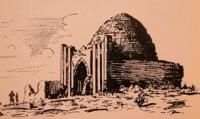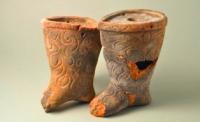Вы здесь
Yangikent and Huvara.


Back in history, the medieval Aral city of Yangikent was the capital of Oguz and was the largest settlement in the lower area of the Syrdaria River. Ships loaded with grain and bread floated along the river.
Yangikent was located along the important caravan route through the Kimak steppes and the Sarysu, Kengir, Ishim and Nura valleys. According to ancient history the Syrdaria River was called Yaksart by ancient authors; the Turkic authors called it Yinchu-uguz and Arabic authors referred to it as Seikhun.
The city of Yangikent was located on the river which bordered the two countries of Northern Turan and Southern Iran where farmers, cattle breeders, cities and steppes were located. The ancient Turkic tribes, Oguzs (guzs), lived here and played an important role in the history and ethnogenesis of medieval Kazakhstan.
According to Arabic historical and geographical sources they established the state at the end of the IX-X centuries. It was the region where different cultures interacted and coexisted, an intersection of migration and trade routes.
The renowned scientist S.P. Tolstov called the territory of the lower reach of the two great Central Asian Rivers, Amudaria and Syrdaria, the "Aral Ethnogenesis Junction". S.R Tolstov analytically and yet romantically as a person in love with archaeology discoveries, described his thoughts upon seeing the ruins of one of the ancient cities as: "I will never forget the impression when suddenly after the severe passage along the desert I found myself at the place of the Angakalin takyrs.
The flat clay valley covered with a purple scattering of antique ceramic spread at the legs of our camels, feet of passed sand dunes. The square grayish-pink walls made of adobe brick covered with many high chinks of gun slots with rectangular towers.
The fort that stood over one and half thousand years looked like it was abandoned only yesterday... A crimson flame of sunset covering the western part of the horizon pointed to the coming next day sand storm.
There, in the west, the black silhouettes of countless towers, houses and castles were cut into the purple sea of the sunset behind the heavy ridge sand dunes we passed. It looked like the silhouette of a large, crowded city".
The remains of the Orguzs' capital still exist today. You can find the ancient settlement Dzhankcnt near Kazalinsk. Kuyuk-Keskenkala and Kuyukkala, two other large ancient settlements, are located further downstream the Syrdaria.
The ancient rectangular shaped city of Dzhankent stretches from the east to the west but is considerably wider in the eastern part. The main street stretches from the west to the east with lanes at a right angle.
Excavations of Dzhankent revealed citadel planning, street networks, palace constructions, fortification, Oguz type ceramics, altars, and censers (incense containers) dating back to the XI - XII centuries.
According to historical sources at the beginning of the XIII century the Yangikent city was conquered by a Mongolian detachment led by Dzhuchi Khan. Unlike the Sygnak, Ashnas and Barchkent residents who resisted the Mongolians were destroyed, and Yangikent's residents surrendered.
Nevertheless the city was relocated 1.5 kilometers to the northwest at the junction of the caravan roads and was the largest centre of Dzhuchi Ulus. Currently the biggest part of the post Mongolian settlement has contemporary constructions which make it difficult to identify its original borders.
Archaeologists uncovered coins made in the cities of the Golden Horde. A mausoleum built of burnt brick and dating back to the XIV century was partially excavated. It is representative of the outstanding architecture with richly decorated glazed blue plates having Arabic inscriptions.
Ibn Haukal, an Arabic author of the X century provided interesting data on Yangikent and referred to it as the "new settlement". In his historical and geographical work he stated the new settlement was not only the capital but the winter headquarters of the Oguz kings.
So, where exactly was the old capital of Oguzs located? According to research the city of Huvara was located near Yangikent (Dzhuvara, Hora). If locating Yangikent is difficult, then identifying Huvara is even more challenging.
Some historians say the city is the ancient settlement of Kuyuk-Keskenkale which can be found near Zhankent (Kyzylorda Oblast). The ruins of this large city with its topography and numerous building materials led it to be identified as existing during the I to XII century AD.
Kuyuk-Keskenkale was the largest settlement on the southern bank of the ancient Syrdaria delta channel. The ancient settlement was surrounded by a rampart about 2 meters high. The fortress had a palace and temple.
Excavations of the settlement are currently in the early stages. The settlement excavations uncovered two layers: the upper one dates back to the X-XII centuries and the lower to the VII-IX centuries.
The upper layer was washed away and destroyed. The lower layer uncovered unearthed streets with large multi-room flat roofed adobe brick houses built with four columns. The archaeologists also uncovered Turgesh, Tan, Kharezm, and Bukharkhudat coins as well as pendants, belt clasps and waist buckles made in foreign countries proving the international links of the city along the Silk Way.
Short decorated conic cups with looped handles attached at the edge were found as well as cylindrical mugs covered with deep bright red engobe (liquid clay) and glossing. Archaeologists also found ornamental pots and cups.
But the most notable find was a gem with a woman's portrait dating back to the IV-V centuries. It was engraved by a skilled master depicting the visible features of a face, hair and clothes.
According to researchers this gem depicts either a real woman or a female goddess. The inscription on the upper part of the gem was interpreted by Iranian language specialists as "Bilbig the daughter of Vakhran".
Archaeologists assumed the gem belonged to the daughter of a noble person, probably the king. Interestingly, the word bilbig in ancient Iranian means "the woman who practices religion".
The first discoveries of the settlement provide materials that will add a new page in the history of Kazakhstan.
Authority:
Karl Baypakov, Dmitry Voyakin.Magazine “Tengri”, 2, 2010.







